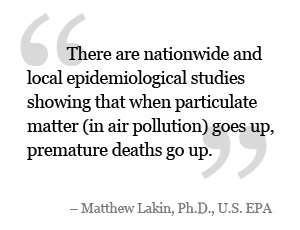Beyond Particulates: Toxins in Wood Smoke
In many areas, wood burning is the largest single source of particle pollution in winter months.
But what about toxic compounds?
A recent study by the Australian EPA sheds some light on this topic, and it’s an eye opener. For example, look at formaldehyde, which is a potent irritant and carcinogen. The study found that in the Sydney region, 38% of the formaldehyde in the air is generated by residential wood heaters.
Another example is polycyclic aromatic hydrocarbons (PAHs), which also cause cancer: 35% comes from wood burning.
Perhaps most frightening is the data for dioxins and furans, which are some of the most toxic compounds known to man–39% is generated by wood burning.
These numbers are even more troubling when you consider that they are annual figures and that wood burning in the Sydney area takes place for only about a third of the year. During the winter months, residential wood heaters likely account for more than 50% of these toxic compounds in the air.
Before you breathe a sigh of relief that you are not living Down Under, bear in mind that wood burning activity in the Sydney area is not any worse than in many areas in the United States and around the globe.
To date, attention has focused mainly on wood burning as a source of particle pollution. This study makes it clear that wood burning’s role as a source of toxic and carcinogenic compounds may pose an even greater threat to human health and to the environment.
Wood Burning vs. Natural Gas: No Contest
Families for Clean Air recently received a letter that asked for references backing up our assertion that the emissions from EPA-certified wood stoves are greater than those from devices that burn natural gas. This information is available from many sources, including the US EPA, but we think the chart below from the Puget Sound Clear Air Agency illustrates the point in a clear and simple manner (you may click on the image to enlarge):
 As bad as this chart may make things look for wood burning devices, we’d like to note that it actually makes the relative performance of wood burning stoves seem more favorable than it actually is. First, the emissions of wood burning stoves are tested under laboratory conditions that bear only a passing relationship to how they are likely to actually be used in the real world. Second, studies have shown that the performance of EPA-certified wood stoves can deteriorate over time.
As bad as this chart may make things look for wood burning devices, we’d like to note that it actually makes the relative performance of wood burning stoves seem more favorable than it actually is. First, the emissions of wood burning stoves are tested under laboratory conditions that bear only a passing relationship to how they are likely to actually be used in the real world. Second, studies have shown that the performance of EPA-certified wood stoves can deteriorate over time.
Thus, the wood stove data probably reflect ‘best case scenario’ stove performance in laboratory conditions.
Any way you slice it, it’s clear that gas burns much more cleanly than wood, leading to less particulate pollution.
New Evidence of the Effect of Wood Smoke on Climate Change
A recent study by scientists at the University of Leeds finds that the influence of soot generated by wood burning on climate change has been greatly underestimated.
This study, which is the first comprehensive and quantitative analysis of the role of soot in the climate system, concludes that particles from wood burning and diesel engines have twice the warming effect calculated in previous estimates. Soot, which is also called black carbon, is second only to carbon dioxide in terms of its effects on warming the climate. This study shows that black carbon has a warming effect approximately two thirds that of carbon dioxide.
Black carbon in the atmosphere absorbs solar heat. This not only heats the atmosphere but also melts the earth’s snowcaps and glaciers when these particles settle on the ground.
Eliminating or reducing wood and other biomass burning may be one of the easiest and most effective ways for us to curb global warming. Co-lead author Dr. Tami Bond notes, “Since black carbon is short lived, the impacts would be noticed immediately.” That’s because while carbon dioxide remains in the atmosphere for relatively long periods, existing black carbon emissions are washed out of the atmosphere in just a few weeks.
“Reducing emissions from diesel engines and domestic wood and coal fires is a no-brainer as there are tandem health and climate benefits,” said Professor Piers Forster from the University of Leeds
This study highlights the fact that not only does wood smoke pollution have harmful effects on human health, wood smoke harms the health of our planet as well.
Reducing Wood Smoke Pollution Saves Lives
A new study published in the British Journal of Medicine has found that reducing wood smoke pollution from wood stoves is associated with significantly reduced risk of death. The study, which was conducted in Australia, looked at a community in which wood stove prevalence fell from 66% to 30% after implementation of a series of interventions aimed at reducing wood smoke. This resulted in a 40% reduction in wintertime air pollution and in reduced all-cause, cardiovascular and respiratory mortality during the period of improved air quality.
The researchers note that their findings “highlight the potential for important public health gains from interventions to reduce ambient pollution from biomass smoke”.
Scientists have long known that air pollution contributes to human sickness and death. A study by Cornell professor David Pimentel estimates that air pollution from smoke and various chemicals kills 3 million people a year worldwide, and hundreds of studies document the harmful effects of wood smoke pollution on human health.
Simply put, reducing wood smoke pollution reduces deaths.
More Evidence of the Benefits of Reducing Wood Smoke Pollution
Want to live longer? Breathe clean air.
New data published in the journal Epidemiology show the importance of fighting to reduce the particle pollution that is generated by wood burning and other activities.
Researchers at the Harvard School of Public Health report that declining air pollution levels continue to improve life expectancy in the U.S. Specifically, data from 545 counties nationwide, both metropolitan and rural, show an average decrease of 1.56 micrograms per cubic meter in particulate pollution from 2000 to 2007 that parallels a life expectancy increase of an average of 0.84 years.
In the winter, wood smoke pollution is the largest source of particle pollution in many communities. Numerous studies have shown associations between acute and chronic exposure to fine particle air pollution such as wood smoke and cardiopulmonary disease and mortality. Studies have also shown that reductions in air pollution are associated with reductions in adverse health effects as well as with improved life expectancy.
“Despite the fact that the U.S. population as a whole is exposed to much lower levels of air pollution than 30 years ago—because of great strides made to reduce people’s exposure—it appears that further reductions in air pollution levels continue to benefit public health,” said lead author Andrew Correia.
The senior author, Francesca Dominici, told the New York Times, “Our paper is strong evidence that additional investment in cleaning the air is beneficial.”
Everyone wants to live a long and healthy life. This winter, let’s work together to reduce wood smoke pollution and breathe cleaner air.






